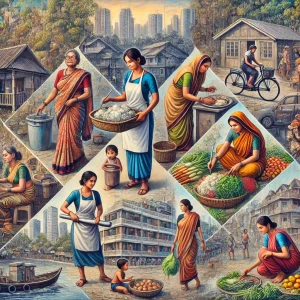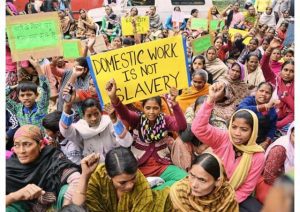West Bengal has long been a significant source of female domestic labor in India, shaped by historical disruptions, socio-economic factors, and urbanization. Women from the state, especially from rural and economically weaker backgrounds, have played a crucial role in the domestic labor sector. From the displacement caused by Partition to present-day employment trends, this article explores how Bengali women have transitioned into domestic work, the challenges they have faced, and the evolving landscape of this sector.
The Impact of Partition on Women’s Labor
The Partition of India in 1947 led to large-scale displacement, particularly in Bengal. Thousands of families, primarily from East Bengal (now Bangladesh), migrated to West Bengal seeking refuge. However, survival became an immediate challenge. Many middle-class and lower-class families found themselves in dire economic conditions, with men often struggling to secure stable employment.
For women, the pressure to contribute financially became urgent. While traditional Bengali society emphasized domestic roles for women within their homes, the harsh realities of Partition forced a shift. Many women, particularly those who had lost their husbands or fathers in the riots, turned to domestic work to sustain their families.
Unlike industrial jobs, which required formal education and specialized skills, domestic work allowed women to utilize their existing skills in cooking, cleaning, and childcare. This period marked the beginning of large-scale female participation in domestic labor, setting the foundation for Bengal’s role as a major supplier of domestic workers in India.

The Evolution of Domestic Work in Bengal
Over the decades, domestic work in Bengal has transformed from an unstructured, necessity-driven occupation to a more organized sector with growing awareness of workers’ rights. While the initial wave of female domestic workers emerged due to economic desperation, the sector gradually evolved as demand for household help increased in urban areas. The rise of nuclear families, economic migration, and changing societal norms played a crucial role in shaping domestic labor in Bengal. However, despite this evolution, domestic workers continue to face significant challenges related to wages, working conditions, and social recognition. Understanding the factors that influenced this shift helps highlight both the progress made and the areas that still require attention.
The Role of Employment ‘Centers’
As the demand for domestic help increased in urban centers like Kolkata, informal recruitment systems began to emerge. These were often referred to as “centers”—middlemen or agencies that connected job-seeking women with households in need of domestic workers. These centers operated on a commission basis, earning money by facilitating employment.
Women who approached these centers were often from villages or refugee settlements, and they relied on the intermediaries to secure jobs in middle-class and upper-class homes. While these centers provided employment opportunities, they also exploited workers, often taking a significant portion of their wages and offering little protection from workplace abuse.


Urbanization and Demand for Domestic Workers
With rapid urbanization in the late 20th century, cities across India, including Kolkata, Mumbai, and Delhi, witnessed a surge in demand for domestic workers. Nuclear families became more common, and with both men and women working, the need for household help increased. Bengali women, known for their reliability and cooking skills, became highly sought after as domestic workers.
The migration of Bengali domestic workers to other Indian states also became a common trend. Many women from West Bengal traveled to metropolitan cities in search of better-paying jobs, as wages in Kolkata were often lower compared to places like Mumbai, Delhi, and Bangalore.
Challenges Faced by Female Domestic Workers
Despite contributing significantly to household management across India, female domestic workers from Bengal have faced numerous challenges.
1. Low Wages and Financial Exploitation
Many domestic workers in Bengal and beyond receive wages that do not match their workload. The absence of standardized pay scales means that salaries vary drastically depending on location, employer, and job responsibilities. In cities like Mumbai and Delhi, Bengali workers often receive better wages than in Kolkata, but even these are insufficient compared to the rising cost of living.
2. Lack of Legal Protection
Domestic work remains part of the informal labor sector, leaving workers without basic labor rights. Unlike factory or office workers, domestic workers often do not receive benefits such as paid leave, health insurance, or pensions. The absence of formal contracts makes them vulnerable to exploitation, sudden termination, and mistreatment.
3. Workplace Abuse and Exploitation
A significant number of domestic workers, especially live-in maids, face workplace abuse, including verbal and physical mistreatment. Cases of unpaid wages, long working hours, and even human trafficking have been reported. Some workers are restricted from leaving their employer’s house, limiting their freedom and making them dependent on the family they serve.
4. Social Stigma and Lack of Respect
Even though domestic workers play an essential role in middle-class and upper-class households, they often face social discrimination. In many homes, they are not allowed to eat at the same table as their employers or use the same utensils. The perception of domestic work as “low-status” employment further adds to the stigma associated with the profession.


Empowerment and Changing Dynamics
Despite the challenges, the landscape of domestic work in Bengal has been evolving. Several factors have contributed to improving the conditions of domestic workers.
1. Skill Development and Higher Wages
Many domestic workers today undergo informal skill training in cooking, childcare, and elderly care, allowing them to secure better-paying jobs. Employers are more willing to pay higher salaries to workers who possess specialized skills, such as knowledge of different cuisines or experience with modern appliances.
2. Unionization and Worker Rights Movements
Organizations and unions advocating for domestic workers’ rights have emerged over the years. Groups like the National Domestic Workers’ Movement (NDWM) and other state-level organizations have been pushing for better wages, legal protection, and fair treatment of domestic workers. These efforts have led to some states introducing minimum wage guidelines for domestic work.
3. Government Interventions
The Indian government has taken steps to address issues related to domestic labor. Some policies now recognize domestic workers under social security schemes, offering benefits like health insurance and pensions. However, the implementation remains inconsistent, and many workers are still unaware of their rights.
The Present and Future of Domestic Work in Bengal
Today, West Bengal remains one of the largest contributors of female domestic workers in India. The demand for Bengali workers extends beyond Indian cities, with many women now migrating to Middle Eastern countries such as the UAE, Saudi Arabia, and Kuwait for domestic jobs.
However, migration for work also comes with risks, as cases of worker exploitation in foreign countries have been widely reported. Many organizations are working to create awareness about safe migration practices to protect workers from trafficking and abuse.
“As West Bengal continues to grow as a hub for economic activities and investment, opportunities in various sectors, including domestic work, are evolving. The state’s investment landscape is also attracting businesses and industries, contributing to job creation and economic stability. Explore more about investment opportunities in West Bengal here.”
Potential Areas for Improvement
- Formalization of Domestic Work: Implementing a structured system where domestic workers receive contracts, standardized wages, and benefits can protect them from exploitation.
- Awareness Programs: Educating workers about their rights, legal protections, and financial literacy can empower them to negotiate better wages and conditions.
- Improved Employer-Employee Relations: Encouraging fair treatment and respectful behavior towards domestic workers can help eliminate the social stigma attached to their profession.


The rise of Bengal as a hub for female domestic labor is a result of historical events, economic shifts, and urban migration. From the impact of Partition to modern-day employment trends, Bengali women have continually adapted to changing circumstances, seeking financial independence and stability through domestic work.
While challenges remain, progress is being made through policy changes, union efforts, and worker training programs. The future of domestic work in Bengal depends on continued advocacy for fair wages, legal protections, and social recognition, ensuring that women in this sector receive the dignity and respect they deserve.

